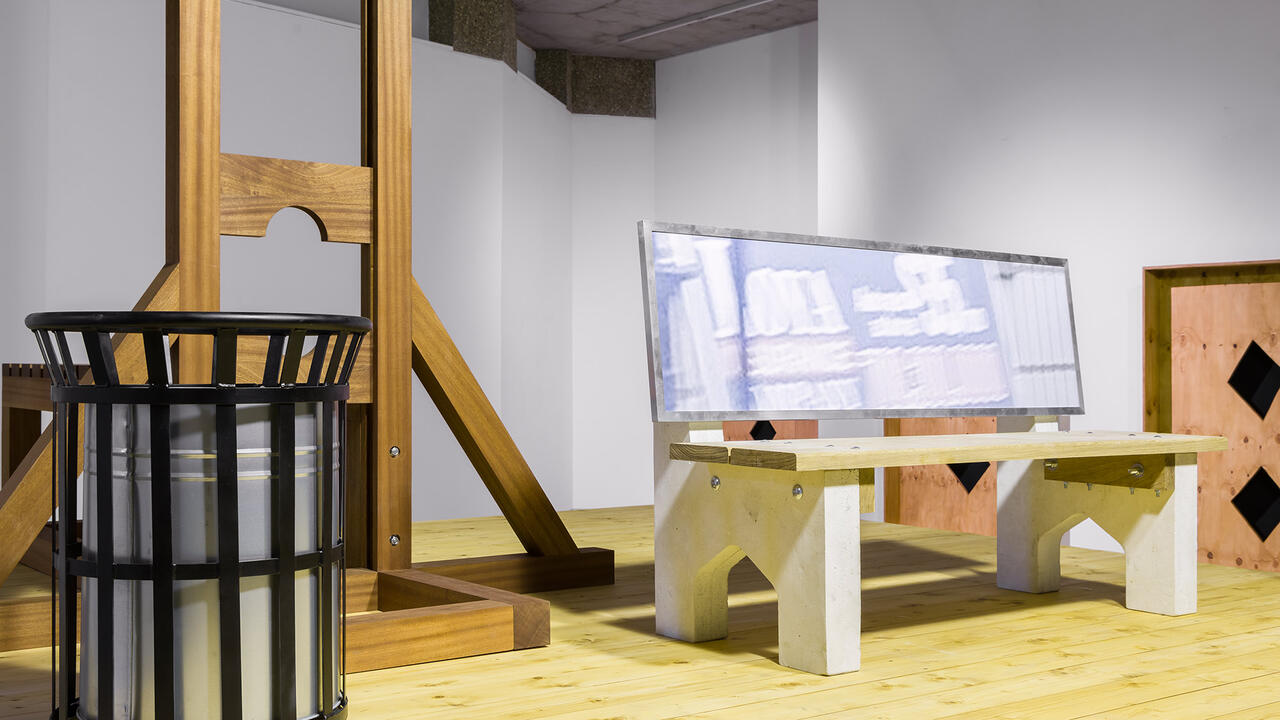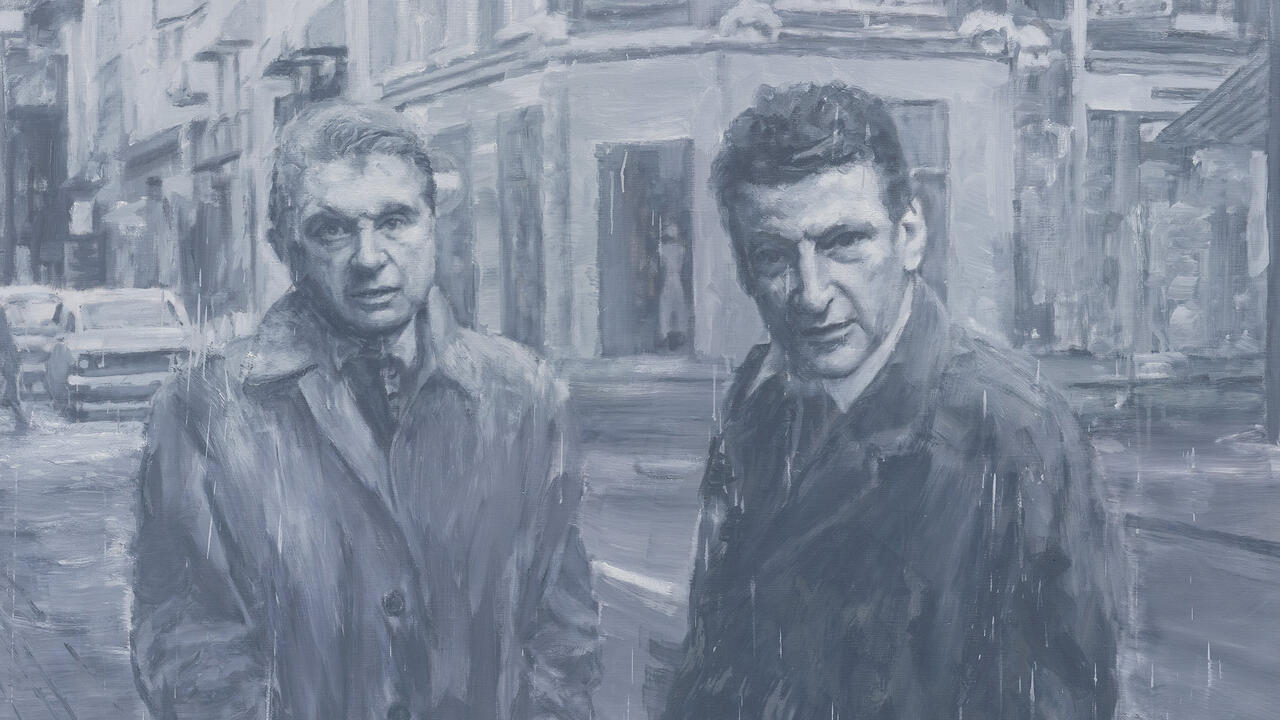Mark Leckey at Tate Britain Review: O’ Magic Power of Bleakness
Is this a show about the artist’s youth or is it about something bigger – landscape?
Is this a show about the artist’s youth or is it about something bigger – landscape?

Mark Leckey is a landscape artist. People will try and tell you that his work is about nostalgia and technology, class and popular culture. Or that it concerns itself with taking old-fashioned words from the sculpture studio – ‘materiality’, say, or ’objecthood’ – and retooling them for the age of digital reproduction. But these are euphemisms for the environmental conditions and airborne pollutants that have altered his brain chemistry. Leckey’s work expresses a profound sense of place and the experiences that bodies mop up and can’t shake off, no matter how far they move away, physically, culturally or temporally. In Leckey’s landscape symbolism, the sun, moon, stars and sea simply have other names; Fiorucci, 7 Windmill Street, Jacob Epstein, the M53 bridge at Eastham Rake.
A life-size section of that bridge cuts through Tate Britain for his new exhibition, ‘O’ Magic Power of Bleakness’. This flyover represents the artist’s journey from childhood in Birkenhead to adulthood in London, a class migrant travelling from the suburbs of the northwest to the capital’s museums. It functions like a giant stone tape, playing a 55-minute cycle of video works: Under Under In (2019), Dream English Kid 1964–1999 AD (2015) and Fiorucci Made Me Hardcore (1999). A Bildungsroman trilogy that runs autobiographical events in Leckey’s life in tandem with bigger shifts in postwar history. Amongst other things: the moon landing, the bomb, the welfare state, pop culture. Or, amongst other things: the sun, moon, stars and sea.

Under Under In evokes an episode from Leckey’s childhood in which he believes he had a supernatural encounter with a sprite underneath the bridge. Mobile phone and CCTV footage of teenagers goofing around plays on five portrait-shaped LED screens. What starts out as adolescent mischief grows stranger, as an unseen presence menaces the teens, forcing them into bodily contortions that imitate the bridge's arc. The group also materializes at the top of an abutment ramp, nestled in an alcove beneath the roadway. They look spectral, drained of colour. A trail of birdshit dribbles from their perch, flecked with glitter, or perhaps fairy dust. The kids’ voices bounce off bridge pillars and spill from service vents, escalating from knockabout teasing to panic. There’s a stiltedness to the delivery of their dialogue, a little like a 1970s ghost movie made by the Children’s Film Foundation. Rather than being a distraction, it gives the work a period quality. Lighting under the bridge flickers from municipal orange into horror-movie purple into a blade of unearthly white light slicing the gallery in two. The video insinuates that their paranormal encounter might be the effects of huffing lighter fluid, or fumes from passing cars. Whether chemical or magical, Leckey wants us to feel as if we are passing through the looking glass to another dimension hidden inside the bridge. Towards the end of the piece, the LED screens strip images of the bridge back to a wireframe representation of itself. Finally, the camera descends into a catacomb or barrow, before darkness engulfs the room.
The bridge structure now feels charged. Its concrete piles look like ancient megaliths. Dream English Kid… is projected along one wall. It maps Leckey’s cultural DNA through sound collage and found footage. The film pins personal specifics – an erotic awakening, a Joy Division gig in Liverpool, a grim squat in London – onto collective memories of NASA missions, The Beatles, ads for Frosties and Cinzano, the fear of nuclear armaggedon, the Y2K bug. The M53 bridge appears throughout, marking time. First, bathed in optimistic dawn light – new infrastructure for a country on the up in the 1960s. With the 1970s, it gathers graffiti and dirt, before finally being left as a ruin in a version of the 1980s that ends with a nuclear bomb.

Closing the cycle is Fiorucci Made Me Hardcore, Leckey’s now cult video tracking British dance culture from 1970s Northern Soul to rave. With floor-spinners at the Wigan Casino, gangs of casuals in city shopping precincts and the ecstatic congregants at acid house parties, Fiorucci… pays recognition to the subcultures that gave generations of British working class youth a collectivity, expression and respite from the grind. Now the perspective pulls outwards again, as if Leckey is taking us up in a weather balloon, climbing from the parochial detail of childhood in Under Under In, through to his self-awakening in the bigger world in Dream English Kid…, and towards the cruising altitude from which we might see bigger historical contours.
All youth culture must grow old. Leckey presents pop as ancient folklore. We hear sounds that are now 30, 40, 50 years old. We’re as far away from them in time as punk or acid house were from music hall and skiffle. These are ghost stories ripe for the re-telling. When Joy Division singer Ian Curtis appears in Dream English Kid, he is only a pixellated blur, a mush of bootleg concert sound, obscured at points by Leckey’s own silhouette. Curtis as a feeling to be owned, rather than a list of facts for middle-aged men to bore you with at parties.

Leckey’s landscapes are made of tiny details and big emotional sweeps. In Dream English Kid…, you might catch an echo of Judy Collins singing ‘Both Sides Now’ (1967) or spot the number 23 graffitied on the bridge, a number that had occult significance for the 1980s British underground. Maybe you’ll recognize a clip from the TV show Threads (1984) or run the lyrics to ‘Kid’ (1979) by the Pretenders in your head as the record label spins before you. (‘Kid what changed your mood / You’ve gone all sad so I feel sad too / I think I know some things we never outgrow…’) You might see a cameraman dodge out of shot in Fiorucci…, reminding you that this is a third-hand memory. But if you forget about making an inventory of Leckey’s references, you might experience the mysterious attraction that this material held for him in the first place. It’s a different form of knowledge to one made of provenances, catalogue numbers and the right curatorial tastes of the day. Naming an experience can place it in history, but can kill its magic.
Walk through the Tate collection on the way to this exhibition, and you will pass Richard Dadd’s hallucinatory painting The Fairy Feller’s Master Stroke (1855–64) and Edward Burra’s The Snack Bar (1930). You’ll see Stanley Spencer’s The Resurrection, Cookham (1924–7) opposite Jacob Epstein’s Torso in Metal from ‘The Rock Drill’ (1913–15) and The Deluge by Winifred Knights (1920). In Spencer’s resurrected Cookham villagers, I see the dancers in Fiorucci…, some who must now be dead, preserved forever in ecstatic celebration. Dadd’s fairy painting holds a séance with the supernatural Under Under In. In The Deluge, people flee the scene of a catastrophic event as terrifying as the nuclear disaster feared in Dream English Kid… (They even seem to be running up an escarpment similar to the one beneath the bridge.) Burra’s snack bar patrons make me think of the fashions in Leckey’s films, worn by people with faces that we no longer see on the streets; preoccupied by anxieties different to ours perhaps, but with desires that remain unchanged. Epstein’s cyborg torso is Leckey’s body, transformed by the electronic pulses of dance music and the promise of life as an artist. In a Berkshire village, a London cafe, underneath a motorway near Birkenhead and in a Wigan nightclub, are people and landscapes transformed and damaged by technology, divided by class and education, but still managing to find moments of collective joy on this troubled island.
‘O’ Magic Power of Bleakness’ runs at Tate Britain until 5 January 2020.
Main image: Mark Leckey, Dream English Kid 1964 – 1999 AD, 2015, production still. Courtesy: the artist; photograh: Mark Blower

























